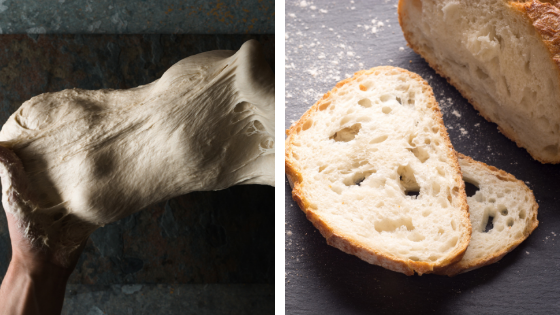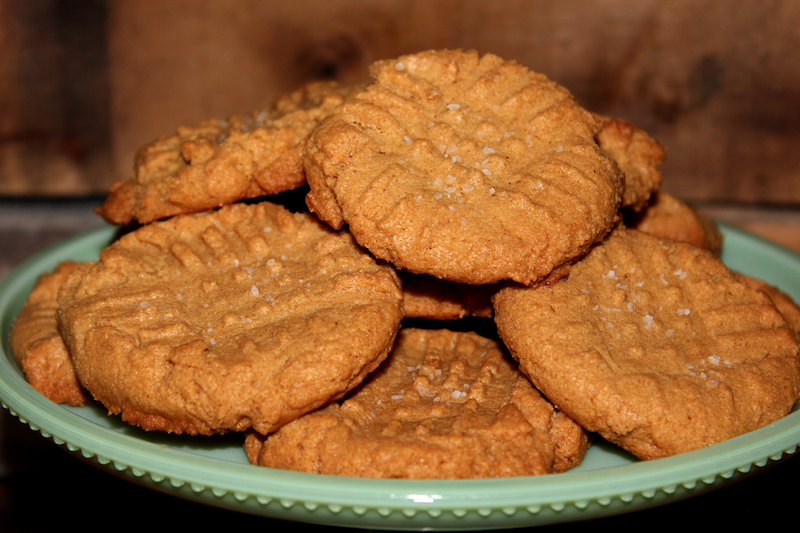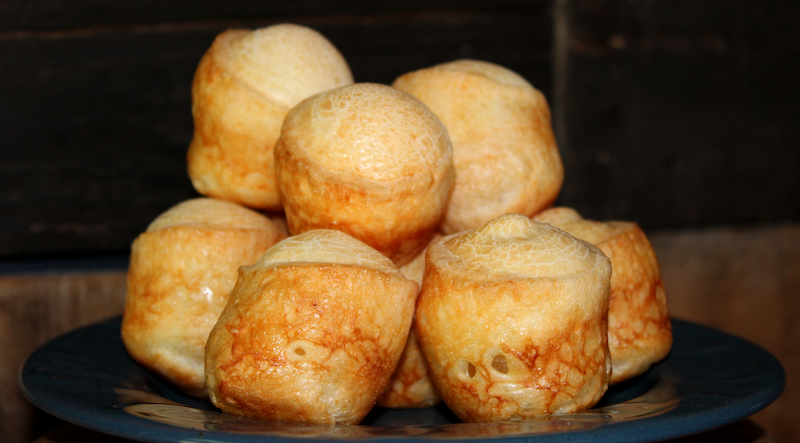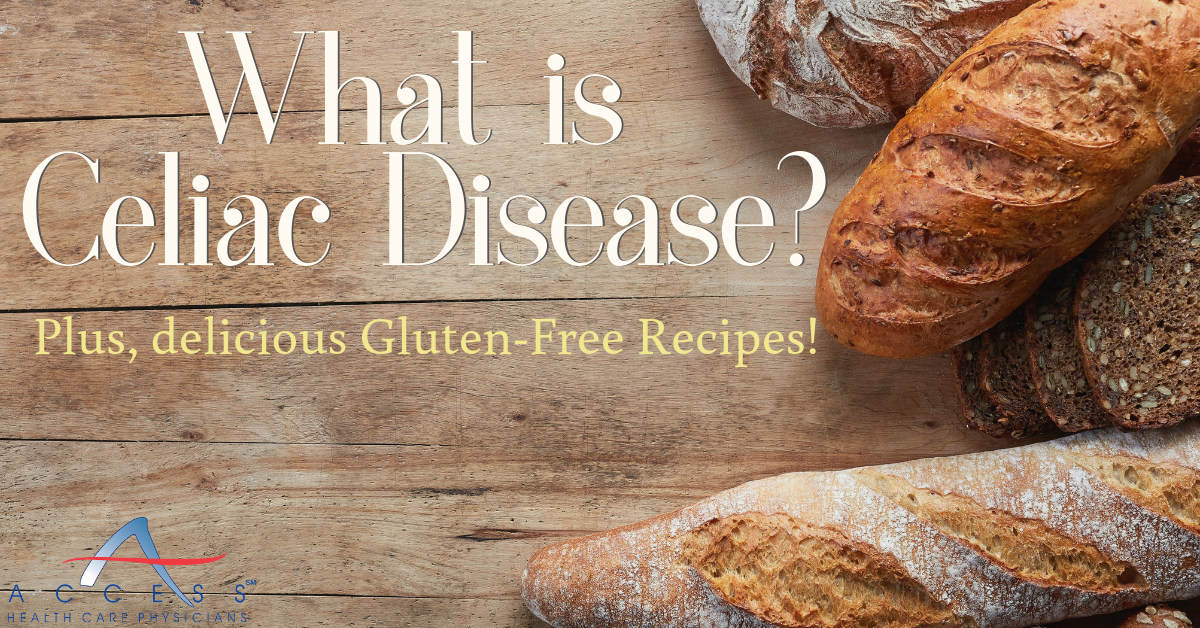Gluten-free may sound like just a trend or another fad diet. We see gluten-free items on menus at local restaurants, recipes on Pinterest and Facebook, and full sections of grocery stores dedicated to gluten-free fare. However, a gluten-free diet is not simply a fad for those with a condition called Celiac Disease. Follow along as we uncover what gluten and celiac actually are, symptoms, diagnosis and more. Plus, don’t miss our time-tested favorite gluten-free recipes at the bottom!
What is Gluten
First, let’s begin with understanding gluten. In simple terms, gluten is actually a family of proteins found in wheat, rye and barley. When flour is mixed with water, these proteins (gliadin and glutenin,) bind together to create a sticky, stretchy consistency. In fact, the name “gluten” is derived from the Latin word for glue! Gluten helps to make dough elastic, giving products made with gluten a nice, chewy texture. It also aids in the rising of bread by trapping gas molecules inside the dough to create a network of air pockets.
To visualize gluten, here are two photos. One of a stretchy, elastic dough. That elasticity is thanks to gluten! The second of a baked loaf of bread. You can see the air pockets that were created as the bread was rising. The elasticity we saw in the dough creates a thin wall that inflates like a balloon when the gases within the bread expand. This is what allows the beautiful holes, known to bakers as an “open crumb.”

Should I Stop Eating Gluten?
For most people, there is no medical reason to eliminate gluten from a healthy, well-balanced diet. In fact, a diet that includes whole grains has been linked to lower risk for heart disease and type 2 diabetes.
However, for some, there is a medical need to eliminate gluten from their diets. These include those with a wheat allergy and the 1% of the US population with celiac disease.
What is Celiac Disease?
Celiac is more than an allergy – it is actually an autoimmune disorder. It affects about 1 in 133 Americans, however, it is estimated that more than 80% of Americans with celiac are currently undiagnosed or misdiagnosed.
Within the walls of your small intestine are small, finger-like projections called villi. These villi are responsible for the absorption of nutrients in your food. When people with celiac consume gluten, an immune response is triggered that causes damage to the villi in the small intestine. This damage causes the villi to be shortened or flattened.
.png)
What are the Symptoms of Celiac Disease?
The most common symptoms for both children and adults typically involve the gut and digestive system. Symptoms can vary greatly person to person and can also vary greatly in the severity of symptoms.
Common Celiac Symptoms in Children
- Abdominal pain & bloating
- Persistent diarrhea or constipation
- Vomiting
- Weight loss
- Irritability & fatigue
Common Celiac Symptoms in Adults
- Abdominal pain & bloating
- Persistent diarrhea or constipation
- Iron-deficiency anemia
- Fatigue or anxiety
- Irregular menstrual periods
- Joint pain & weak bones
- Skin disorders
- Loss of tooth enamel & tooth discoloration
Another common symptom of celiac disease is a rash called dermatitis herpetiformis, called DH for short. This rash is made up of bumps and blisters, is intensely itchy and effects up to 25% of those with celiac disease. Typically, those who experience DH do not experience the common digestive symptoms.
Am I at Risk for Celiac Disease?
There are a few factors that may increase the risk for celiac disease.
- Family history of celiac – there is a greatly increased risk of celiac in those with a first degree relative with the disease.
- Those diagnosed with:
- Lupus
- Rheumatoid arthritis
- Type 1 Diabetes
- Down Syndrome
- Lactose Intolerance
- Thyroid Disease
- Other autoimmune conditions
How is Celiac Disease Diagnosed?
There are several ways celiac disease can be diagnosed. The most common is a blood test, which is typically performed while gluten is still in the diet.
Your doctor will review your blood work for two antibodies that often are very high in those with celiac disease - antiendomysium (EMA) and anti-tissue transglutaminase (tTGA).
For those with the dermatitis herpetiformis (DH) rash, a biopsy of the skin can help your doctor diagnose celiac.
In the event the results of the blood test or skin biopsy are inconclusive, an endoscopy can be used to test for and diagnose celiac disease. During an endoscopy, a thin tube with a small camera attached is lowered through the mouth into the small intestine. This allows the doctor to examine any possible damage the small intestine and villi, a tell-tale sign of celiac. In some cases, a small biopsy may also be taken from the intestine.
What are the Treatments for Celiac?
Unfortunately, there is no cure for celiac disease. The only way to treat this condition is to completely and permanently remove gluten from your diet. Your doctor should have tips for you to help eliminate gluten from your diet while still enjoying a healthy, well-balanced variety of foods.
You will also be taught how to read food labels to look for ingredients that may contain gluten.
What are the Ingredients and Foods to Avoid with Celiac Disease?
Here are a few of the major foods and ingredients to avoid, however, your doctor will have a more comprehensive list.
- Wheat
- Spelt
- Rye
- Barley
- Semolina
- Bulgur
- Triticale
The following foods should generally be avoided, unless the label specifically states that it is gluten-free.
- Breads
- Beer
- Cakes, pies, cookies and crackers
- Cereal
- Sauces and gravy
- Soups and pasta
- Processed meats, lunch meat and hot dogs
What Foods are Gluten-Free?
You can enjoy a wide array of delicious foods while on a gluten-free diet. Be sure to always check the ingredient labels.
- Fruits & vegetables
- Rice, beans and lentils
- Fresh meats, fish & poultry (be sure there is no breading, seasoning or marinades)
- Most dairy products
There are also several grains and starches that can be enjoyed on a gluten-free diet, including:
- Quinoa
- Rice
- Tapioca
- Cornmeal
- Buckwheat
- Flours made from rice, soy, corn, potatoes, beans and tapioca
- Arrowroot
Be sure to check labels, there are many items that may contain hidden gluten. These often include:
- Granola & protein or meal-replacement bars
- Potato chips
- Even vitamins, ground spices and chewing gum may contain gluten.
While celiac disease is a lifelong condition, the symptoms can be controlled by enjoying a gluten-free diet and regular checkups with your doctor. The great news is that a gluten-free diet is becoming even easier to enjoy thanks to more options in local supermarkets and easy access to great recipes. Gluten-free can be delicious! Keep reading for a few of our favorite, taste-tested and approved, gluten-free recipes.
Gluten-Free Cornbread
2 eggs
2 cups white stone-ground cornmeal
2 cups buttermilk
1 teaspoon baking powder – Gluten Free
1 teaspoon baking soda
¼ cup bacon grease
Salt to taste (the bacon grease probably provides enough salt)
Instructions
Preheat oven to 425 degrees.
Mix dry ingredients in a medium bowl. Whisk eggs into buttermilk in a separate bowl and then gently mix into dry ingredients to combine.
Put bacon grease into a cast-iron skillet over medium heat.
Just as the bacon grease is about to start smoking, pour enough cornbread batter into the skillet to coat the bottom and sides, stirring and moving skillet as need to coat evenly.
Then, pour the remaining mixture into skillet.
Bake until cornbread is golden brown, springy in the middle and pulling away from sides – about 15 to 20 minutes.
Remove from oven and carefully remove from skillet.
Gluten-Free Peanut Butter Cookies
Deliciously simple, these are easy to bake with ingredients you probably already have at home!
Ingredients
1 cup peanut butter
1 cup sugar
1 teaspoon pure vanilla
1 large egg – lightly beaten
Coarse sea salt for sprinkling
Instructions
Preheat oven to 350 degrees.
Mix peanut butter, sugar, vanilla and egg in a medium bowl until well combined.
Spoon 1 tablespoon of cookie batter about 1 inch apart onto ungreased cookie sheet.
Flatten mound with the tines of a fork making a crosshatch pattern.
Sprinkle with coarse salt.
Bake until golden brown, about 10 minutes. For best result, rotate cookie sheets halfway through.
Let cool 5 minutes on the tray before transferring to rack to cool completely.

Gluten-Free Brazilian Cheese Bread (Pão de Queijo)
Warning: These little chewy, cheesy bites are so good, you’ll have difficulty sharing! The inside remain soft and chewy while the outside is crisp and golden.
Ingredients
1 large egg
1/3 cup extra virgin olive oil
2/3 cup milk
1 ½ cups gluten-free tapioca flour
½ cup gluten-free grated cheese (packed – we love freshly grated parmesan. Feta also works well)
1 teaspoon salt (or more to taste)
Instructions
Preheat oven to 400 degrees and grease mini muffin tins (use one 24-well or two 12-well mini muffin tins.)
Place all ingredients into a blender or food processor and pulse until smooth. Use a spatula to scrape down the sides to ensure it is blended well.
(Tip – this batter can then be stored in your refrigerator for up to one week!)
Pour batter into mini muffin tins, leaving about 1/8” from the top.
Bake at 400 degrees for 15-20 minutes. They will be puffed up significantly and golden brown.
Remove from oven and allow to cool on rack. Enjoy while warm.

Gluten-Free Macaroni and Cheese
Known as "THE" Macaroni & Cheese, this recipe is a crowd-pleaser!
Ingredients
6 tablespoons butter
1-pound corkscrew pasta – Gluten-free
5½ cups milk
½ cup all-purpose flour – Gluten-free
2 teaspoons salt
¼ teaspoon ground pepper
3 ¼ cups (10 oz.) grated white cheddar cheese (Divide out 2 ¾ cups. Reserve the remainder.)
3 ¼ cups (10 oz.) grated sharp cheddar cheese (Divide out 2 ¾ cups. Reserve the remainder.)
Instructions
Heat oven to 375 degrees, lightly butter deep baking dish.
Cook pasta 2 to 3 minutes less than directed on package. Rinse, drain and set aside.
Microwave milk until hot.
In a high-sided skillet, melt butter. When butter begins to bubble, stir in flour. Cook, whisking constantly for approx. 1 minute. While still whisking, stir in hot milk. Continue cooking and whisking until mixture bubbles and becomes thick ~ 7 to 10 minutes.
Remove pan from heat. Stir in the salt, pepper, and 2 ¾ cups of each of the cheeses. Add drained pasta into the cheese sauce, and stir until all the pasta is covered.
Spoon macaroni and cheese into prepared dish. Sprinkle with remaining cheeses.
Bake until brown on top – approx. 25 minutes. (Optional – cover with aluminum foil for the first 15 minutes to keep the pasta from drying out. Then uncover to brown for the remaining 10-15 minutes.)
To learn more, and keep up with our latest updates, be sure to "Like" and follow us on Facebook, Instagram and check our Blog page often.
Written by S. Campbell for Access Health Care Physicians, LLC
Recipes generously provided by D. Gude.


